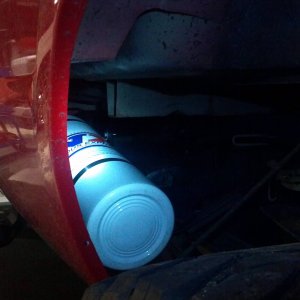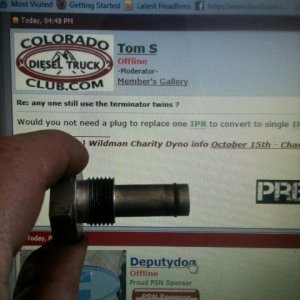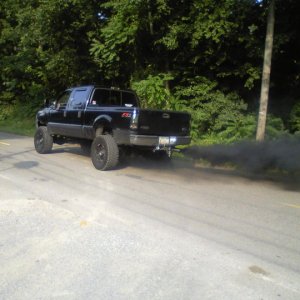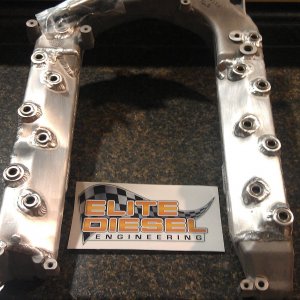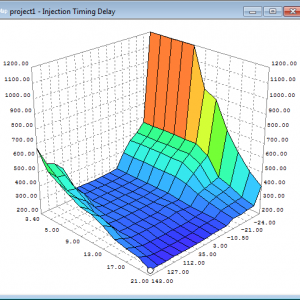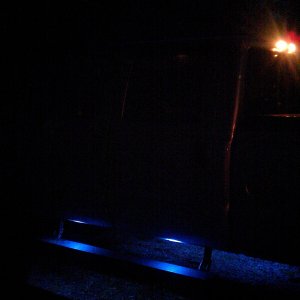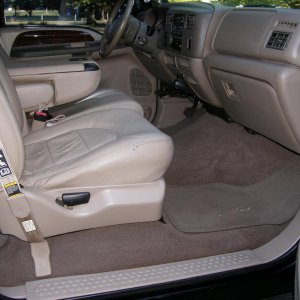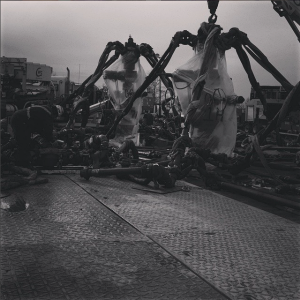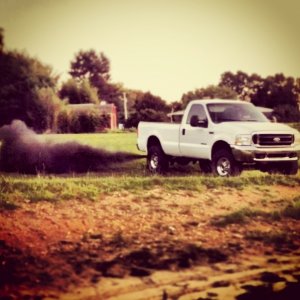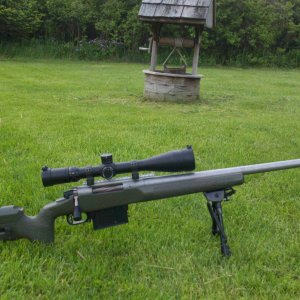Important, things to Remember/Provide in troubleshooting a 6.0L (and a list of things we need to see when you need help) -
.
Help US help YOU!
.
AGAIN - get this information together if you want good help!
.
Moving on to DATA Collection:
.
1. Checking for codes with a GOOD scan tool is essential. Not all scan tools will pull all the codes that are actually in the PCM. A quality scan tool is not expensive at all. ForScan and Torque Pro downloads (with the OBDII adapter) are not expensive. Reading engine data (PID values) is also very important. Most scan tools do an adequate job of this!
SO: read the codes, write down the code numbers, and then when you post in a forum, provide these code numbers in your post!
2. Battery voltage is important. Processors can quit working properly if the voltage gets too low. Static battery voltage is not an indication of a good battery. A battery can have the appropriate voltage at rest, and then not be able to supply proper current (amps). Also - even new batteries can be bad. 12.6-12.7 volts indicates a full charge, but a load test is the critical step! Cranking battery voltage should be AT LEAST be 10.5 volts. The more the better, but ONLY up to a point! Charge and load test the batteries individually before troubleshooting - PLEASE!!
3. Cranking rpms are important. Fueling commands won't occur below 100 rpm, and functionally 150 rpm or more is required for a reliable start (because of the need for good cylinder compression, high pressure oil pressure, etc).
4. A minimum ICP pressure of 500 psig is required for FICM Sync. HOWEVER, under certain circumstances the PCM will ASSUME a proper ICP value. It is CRUCIAL to watch ICP sensor voltage output. A minimum voltage of approximately 0.8V is required. This voltage will tell you whether or not the PCM is assuming a false ICP pressure value.
5. There are TWO Syncs. One is Cam/Crank SYNC and the other is FICM Sync. Both are required before the engine will start. It is entirely possible to have FICM Sync without Cam/Crank SYNC contrary to what many seem to think. The rpm value is a critical factor in troubleshooting SYNC issues.
6. It is important to have functional glow plugs. Many people think glow plugs are an unimportant supplementary part of the engine functionality. While this can sometimes be true, just bite the bullet and FIX the failed components if you have glow plug codes/issues.
7. Aftermarket filters are a problem. Just get OEM filters - period. Buy from a dealership (on-line dealerships are cheaper) or from DieselFiltersOnLine ($250 there and you get free shipping - brings the overall price down a bunch, and easy to get to $250 now days!). So if you haven't paid attention to filters in the past, start looking into what a counterfeit or aftermarket filters would look like.
In fact, aftermarket parts are a big problem. In general, stick with OEM parts from reputable suppliers (note- there are a few specific cases where aftermarket parts are better). On-line dealerships like Tasca and AutoNation White Bear Lake are good examples of reputable suppliers. They give 15% discounts. Other shops can have great pricing too, but you need to compare prices that include the cost of shipping (Riff Raff, CNCFab, DieselFiltersOnLine, BulletProofDiesel, Full Force Diesel, KC Turbo, are some other examples of great places to buy parts).
8. The early HPOPs ('03 and '04) are significantly less reliable than the later HPOPs ('05 and up). ALL '03's and '04's have the round aluminum HPOP. The reliable HPOPs (cast iron) did not get installed until the '05 model year. The confusion seems to be because the late '04's have the wavy oil rail and the newer standpipes and dummy plugs. This is possible because the late '04's have their very own unique branch tubes!
9. We (forum resources) can provide quite a bit of help for folks having problems. That said, we absolutely need GOOD COMMUNICATION! Details matter! Pictures can be a big help also! Also, please be VERY WARY with shops - even dealerships. Even if you have to take the truck to a shop, we can provide you with guidance that can POSSIBLY help you avoid the potential of excessive and unnecessary repair costs. The more you know, the better equipped you will be to recognize if/when the shop is taking advantage of you.
10. When troubleshooting a no-start, many people have read on the Internet that disconnecting the ICP sensor can possibly enable you to start the engine. This can only help when you have a problem with the ICP sensor itself. It will not help at all if you actually have a problem with developing sufficient pressure in the high pressure oil system. Also, remember - trying to start with the ICP sensor disconnected WILL THROW A P2285 code. Often times people think that this code means a failed ICP sensor or bad wiring to the ICP sensor when it really is due solely to the attempted start with the sensor unplugged.
.
Data to collect before posting: (provide this information when you do decide to start a thread):
Vehicle Info Input:
Symptoms (Describe):
Operating Conditions: ESPECIALLY If it is a Crank No-Start, begin by filling in the data requested below:
KOEO:
Media Input Photos - Pictures of top of engine are really helpful at times!
Videos - A video of cranking data sometimes is a big help also! It may require posting the video to YouTube and then posting the link in your thread.
This is a good thread on troubleshooting a no-start:

 www.powerstroke.org
www.powerstroke.org
.
Help US help YOU!
.
FIRST, before anything else, we need to know what model year engine you have .... and if it is a 2004, then we need to know where the ICP sensor is located. Ask for help on this if you need to! Then we need to know all about the truck: ANY recent work done, What parts were replaced, where the parts came from if parts were replaced, and a detailed discussion on what is wrong. Get this information together and then read the rest of this thread!
.SECOND - check the basics: Check the oil level. If it is too low OR too high, then you might have an issue. If it is too high, smell the oil on the dipstick. It might be fuel diluted and this can cause a no start., Check the air filter "filter minder". Does it indicate that the air filter is plugged? Wouldn't hurt to pull and inspect the air filter. Remove the WIF (Water in Fuel) drain plug in the HFCM (Primary Fuel Filter ). Drain a few ounces in a glass jar (or clear container) so you can visually inspect the fuel quality. Does it contain any sludge, dirt, or water? Let us know when the last time oil, fuel and air filters were changed (hopefully you know that!).
AGAIN - get this information together if you want good help!
.
Moving on to DATA Collection:
.
1. Checking for codes with a GOOD scan tool is essential. Not all scan tools will pull all the codes that are actually in the PCM. A quality scan tool is not expensive at all. ForScan and Torque Pro downloads (with the OBDII adapter) are not expensive. Reading engine data (PID values) is also very important. Most scan tools do an adequate job of this!
SO: read the codes, write down the code numbers, and then when you post in a forum, provide these code numbers in your post!
2. Battery voltage is important. Processors can quit working properly if the voltage gets too low. Static battery voltage is not an indication of a good battery. A battery can have the appropriate voltage at rest, and then not be able to supply proper current (amps). Also - even new batteries can be bad. 12.6-12.7 volts indicates a full charge, but a load test is the critical step! Cranking battery voltage should be AT LEAST be 10.5 volts. The more the better, but ONLY up to a point! Charge and load test the batteries individually before troubleshooting - PLEASE!!
3. Cranking rpms are important. Fueling commands won't occur below 100 rpm, and functionally 150 rpm or more is required for a reliable start (because of the need for good cylinder compression, high pressure oil pressure, etc).
4. A minimum ICP pressure of 500 psig is required for FICM Sync. HOWEVER, under certain circumstances the PCM will ASSUME a proper ICP value. It is CRUCIAL to watch ICP sensor voltage output. A minimum voltage of approximately 0.8V is required. This voltage will tell you whether or not the PCM is assuming a false ICP pressure value.
5. There are TWO Syncs. One is Cam/Crank SYNC and the other is FICM Sync. Both are required before the engine will start. It is entirely possible to have FICM Sync without Cam/Crank SYNC contrary to what many seem to think. The rpm value is a critical factor in troubleshooting SYNC issues.
6. It is important to have functional glow plugs. Many people think glow plugs are an unimportant supplementary part of the engine functionality. While this can sometimes be true, just bite the bullet and FIX the failed components if you have glow plug codes/issues.
7. Aftermarket filters are a problem. Just get OEM filters - period. Buy from a dealership (on-line dealerships are cheaper) or from DieselFiltersOnLine ($250 there and you get free shipping - brings the overall price down a bunch, and easy to get to $250 now days!). So if you haven't paid attention to filters in the past, start looking into what a counterfeit or aftermarket filters would look like.
In fact, aftermarket parts are a big problem. In general, stick with OEM parts from reputable suppliers (note- there are a few specific cases where aftermarket parts are better). On-line dealerships like Tasca and AutoNation White Bear Lake are good examples of reputable suppliers. They give 15% discounts. Other shops can have great pricing too, but you need to compare prices that include the cost of shipping (Riff Raff, CNCFab, DieselFiltersOnLine, BulletProofDiesel, Full Force Diesel, KC Turbo, are some other examples of great places to buy parts).
8. The early HPOPs ('03 and '04) are significantly less reliable than the later HPOPs ('05 and up). ALL '03's and '04's have the round aluminum HPOP. The reliable HPOPs (cast iron) did not get installed until the '05 model year. The confusion seems to be because the late '04's have the wavy oil rail and the newer standpipes and dummy plugs. This is possible because the late '04's have their very own unique branch tubes!
9. We (forum resources) can provide quite a bit of help for folks having problems. That said, we absolutely need GOOD COMMUNICATION! Details matter! Pictures can be a big help also! Also, please be VERY WARY with shops - even dealerships. Even if you have to take the truck to a shop, we can provide you with guidance that can POSSIBLY help you avoid the potential of excessive and unnecessary repair costs. The more you know, the better equipped you will be to recognize if/when the shop is taking advantage of you.
10. When troubleshooting a no-start, many people have read on the Internet that disconnecting the ICP sensor can possibly enable you to start the engine. This can only help when you have a problem with the ICP sensor itself. It will not help at all if you actually have a problem with developing sufficient pressure in the high pressure oil system. Also, remember - trying to start with the ICP sensor disconnected WILL THROW A P2285 code. Often times people think that this code means a failed ICP sensor or bad wiring to the ICP sensor when it really is due solely to the attempted start with the sensor unplugged.
.
Data to collect before posting: (provide this information when you do decide to start a thread):
Vehicle Info Input:
- Make
- Model (including vehicle AND Engine year):
- Drive:
- Engine:
- Stock / Modified:
- Tuned:
- Scanner used? - (FORScan or Torque Pro recommended)
- DTC Codes?
Symptoms (Describe):
Operating Conditions: ESPECIALLY If it is a Crank No-Start, begin by filling in the data requested below:
KOEO:
- ICP sensor volts
- FICM MPower
- FICM LPower
- FICM VPower
- IPR % Duty Cycle
- Cam/Crank Sync
- FICM Sync
- FICM MPower
- FICM VPower
- FICM LPower
- Injector Pulse Width
- rpm
- ICP sensor volts
- ICP pressure
- IPR % Duty Cycle
- v-reference voltage
Media Input Photos - Pictures of top of engine are really helpful at times!
Videos - A video of cranking data sometimes is a big help also! It may require posting the video to YouTube and then posting the link in your thread.
This is a good thread on troubleshooting a no-start:

Troubleshooting a No-Start condition
Last edited:

